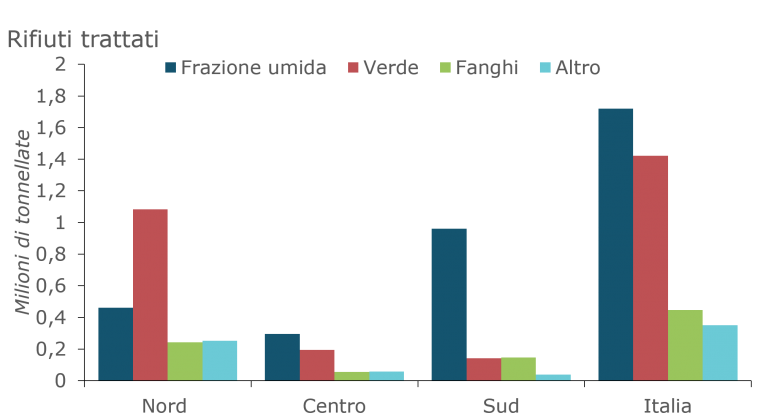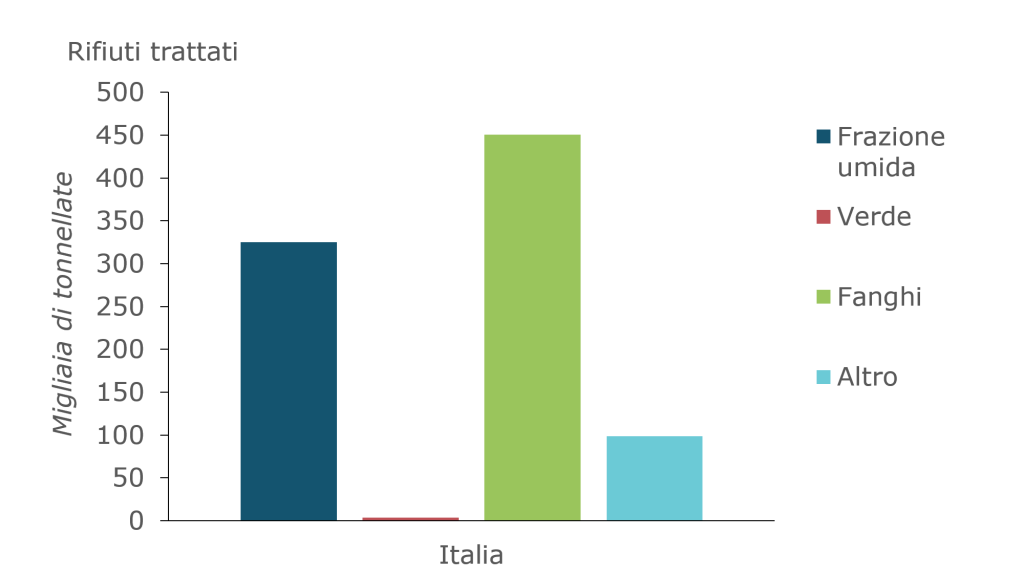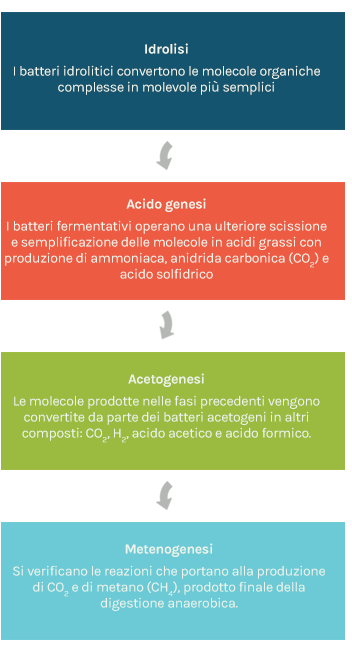Biological Treatments
Organic Waste
Organic waste is characterized by the presence of still putrescible substances. Organic waste consists of food residues collected separately and green waste collected at municipal recycling sites.
According to ISPRA estimates, in Italy the organic part of municipal solid waste represents about 35% by weight of urban waste.
This category of waste must be subjected to adequate treatments in order to break down the organic component in a controlled manner and transform the waste into reusable stabilized material.
Depending on the process, energy can also be produced.
Two treatment types are preferably used for this type of waste: composting and anaerobic digestion, which involve the decomposition of organic material in the presence and absence of oxygen, respectively.

Composting
Composting
Composting is a biological process that takes place in the presence of oxygen, the purpose of which is to transform (technically “to degrade”) the organic substance contained in the waste: bacteria, fungi and molds decompose organic substances into simpler compounds, transforming waste into compost, a stable material free of pathogenic microorganisms.
Compost is rich in humic acids, the same ones found in soil humus, and for this reason it is used in agriculture as a fertilizer.
The characteristics of the compost vary according to the type of waste that is stabilized and to the process conditions: we speak of green composted soil amender when only the vegetable fraction is used, while the mixed composted soil amender is obtained from a mixture of vegetable fraction and OFMSW. In both cases, the legislation establishes the requirements that compost must have in order to be used in agriculture (organic carbon and nitrogen content, plastic moisture, pH, metal and plastic content, etc.)
The composting process consists of two main phases:

- Accelerated bio-oxidation (about one month): it is the active phase in which the forced insufflation of air and periodic turning of the material is foreseen. This is where most of the degradation takes place;
- Maturation (about two months): the humification of the organic substance is completed.
Downstream of maturation, the compost is refined by screening and any other treatments, to be sent to market.


The process
Microorganisms decompose the biodegradable organic fraction, drawing energy and nourishment from it. The degradation reactions modify the chemical composition of the waste, reduce its volume and weight and lead to the development of heat.
The parameters and stages of the process
The variables that influence the aerobic degradation process are different:
Humidity: it is essential to ensure a sufficient water content that is necessary to carry the microorganisms and to allow their metabolic activity, operating, if needed, with periodic irrigation of the material. However, excessive humidity can hinder the diffusion of oxygen in the waste mass and slow down bacterial activity.
Nutritional elements: carbon, nitrogen and phosphorus are the necessary elements for the growth of microorganisms. If there is a lack of nutrients, it may be useful to mix the material with other highly organic matrix waste (e.g. sewage sludge).
Oxygen: a fundamental element for the maintenance of the aerobic process of bio-oxidation, therefore an air insufflation system is always provided inside the pile of material to be degraded.
Temperature and pH: these two parameters vary during the process identifying the different stages of composting.
Accelerated bioxidation – In this phase, the main biological degradation reactions take place, starting with the decomposition of the easily biodegradable organic substance: during this mesophilic stage, the activity of bacteria is very intense and leads to an increase in temperature up to 40 ÷ 50 ° C and a lowering of the pH (5 ÷ 6). Afterwards, the thermophilic stage starts, in which the previously active bacteria are replaced by those able to survive at higher temperatures and the mass of waste reaches 70 ° C and pH values around 7. This phase allows the degradation of the less volatile organic substances.
Maturation – Once the biodegradable organic substance is exhausted, the compost stabilizes: the bacterial activity slows down, the temperature drops to the ambient value and the pH around neutral or slightly basic values.
The high temperatures recorded in the thermophilic stage are essential to ensure the removal of any pathogens: for sanitary purposes it is in fact necessary to keep a T> 55 ° C for at least three days.
Technologies
Composting in heaps (open piles)
The organic material is arranged in heaps with a trapezoidal or triangular section, placed outdoors in specific areas equipped with a draining system for rainwater and washout.
The plant must also include a system for turning over the heaps in order to ensure the correct oxygenation of the material, for example by means of a mechanical shovel or automatic turning machines.
In the past this was the most used system, but today it is preferred to have the process to take place in closed spaces, in order to avoid the spread of unpleasant odors.
Static ventilated batteries
The waste is placed in piles covered with mature compost which has the purpose of acting as a biofilter for odors. In this case the piles are not moved (so they are called static), but oxygenation is guaranteed thanks to the insufflation of air through special perforated pipes placed under the material.
Composting in a closed reactor
The bioxidation phase is performed inside a closed reactor, in which the material is subjected to intense transformation processes that allow to considerably reduce the bioxidation times, following which it is transferred to external areas to complete the maturation phase.
The reactors are always equipped with forced air insufflation systems and can be of the static type (biocells – if the material does not undergo movement during the bioxidation phase), or provided with the waste turning over by means of augers or rotation of the digester itself (rotary drum reactor).
Home-composting
In recent years, the habit of «home-composting» has been spreading: domestic composters are containers in which to throw vegetable food waste and green waste and in which biological transformations with natural oxygenation take place. After a few weeks of residual waste in the container, the compost produced can be extracted from the bottom and used for your gardening.
Anaerobic digestion
Anaerobic digestion
Anaerobic digestion is the degradation process of organic matter led in the absence of oxygen. It is therefore carried out in closed reactors (digesters) and leads to the transformation of the biodegradable material into biogas and digestate.
Biogas is the gaseous product consisting mainly of methane (≈55 ÷ 65%) and carbon dioxide and has a high calorific value (≈17 ÷ 21 MJ / Nm3). For this reason, it can be used as a fuel to produce electricity and heat.
Alternatively, the biogas can be subjected to a process of CO2 removal (called “upgrading”), which allows to recover the biomethane to be injected into the natural gas grid or to be used as a fuel for automotive.
The digestate is a by-product of the process that has amending properties, by improving the physical qualities of the soil. Therefore it can be used directly in agriculture or subjected to an aerobic composting phase to be further stabilized.
When compared with composting, anaerobic digestion is a more complex process to be managed and has higher investment costs. Despite this, it can be convenient thanks to the economic and environmental benefits deriving from energy recovery.
The incoming waste is usually pre-treated by shredding, homogenization and addition of water, then it is sent to the reactor, where it undergoes degradation, divided into four biological phases hydrolysis, acidogenesis, acetogenesis and methanogenesis at the end of which the production of biogas takes place.


The process
The parameters
The temperature is a determining factor for the entire process: it affects its speed and progress, but also contributes to the selection of the different bacterial populations involved, which run at different temperature ranges:
- Psychrophilic bacteria: T = 4 ÷ 15 ° C;
- Mesophilic bacteria: T = 20 ÷ 40 ° C;
- Thermophilic bacteria: T = 45 ÷ 70 ° C.
Other parameters / factors necessary to guarantee the success of the process:
- pH between 6.5 and 7.5
- Undissociated ammonia <several hundred mg of nitrogen / L
- Alkalinity = 1000 ÷ 5000 mg / L
- Necessary nutrients: nitrogen and phosphorus
- Volatile fatty acids <250 mg / L
- Absence of potentially toxic elements such as heavy metals and sulphides
Biogas and biomethane
Biogas is the main product of the anaerobic digestion process and can be used to produce energy, essentially in two ways:
- Direct combustion for electricity generation
In internal combustion engines, gas turbines and microturbines to generate electricity, which can be sold to the Grid Operator.
This choice, currently the most popular, is profitable if, alongside the sale of electricity, the use of additional heat is envisaged.
- Upgrading to biomethane
It consists in the production of methane starting from the biogas, through the removal of CO2 and H2S contained in the gaseous mixture.
The biomethane thus obtained can be used as a fuel to power vehicles (gaseous or liquefied) or be fed directly into the national gas network.


